Sterling Allen, an Austin artist and co-founder of the gallery Okay Mountain, first came to Glasstire's attention in the Austin Museum of Art's 2005 triennial, 22 to Watch. The following conversation took place in May 2007 and is reprinted from the catalogue of his first solo exhibit, Sterling Allen: Writesy Drawsy, at Austin's Art Palace Gallery.
Sterling Allen...Bush...2007...Plastic, cloth, wood, metal, rubber, foam and plush...36 x 34 x 24 inches...Collection of Elaine Bradford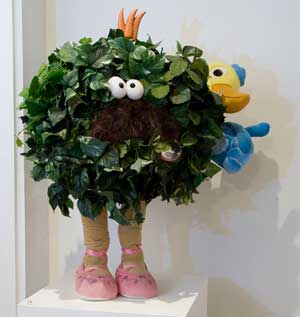
Risa Puleo: It seems in your previous work, translating found photographs into line drawings is as much about drawing as it is reframing and re-contextualizing the image.
Sterling Allen: The images I chose for the photo-drawings are so perfect as photos that I wanted to bring them out there for people to look at as artwork, because I felt that’s what they are. By drawing them, I was able to re-present them on paper, in a frame so that they could be appreciated that way.
Humor is really important to me. It’s one of the things I want people to get out of the photo-drawings. I am very serious about selecting photographs and making the drawings, but humor is a huge part of it. When I look for photos, I try to get inside the head of whoever shot a particular photo. Film costs money and there is a limited number of photos on a roll, so it is really a commitment to shoot a photograph. Even if it’s the smallest commitment, there still is a brain charge that says “this is a moment,” even if it’s a banal moment. Having taken a lot of photographs, I can’t unlearn the rules of good photography—like not cropping at the ankles. To see these decisions and compositions in other people’s photographs, through someone else’s eyes, makes them constantly fresh and keeps me going back to them. I look for somewhat bizarre moments, stuff that people wanted to capture that I wouldn’t have seen as worth being a photograph.
RP: I’m interested in how you are choosing the photographs for their amateur quality and this idea of unlearning photography. For instance, in Untitled (Golf Buddies), whoever took the photograph cropped off the heads of the people in the photograph. How does skill relate to the Picasso image that you’ve re-drawn for Writesy Drawsy? Picasso’s Portrait of Igor Stravinsky (1920) is often used to teach drawing. By turning the image upside down, students can focus on copying lines rather than trying to render the image directly.
SA: I’m really tied to photographs and have been for so long. When I work from photos, I try to replicate what I see as close to the source as possible, which has kept me in a rigid drawing mode, instead of allowing me to explore a more loose and freed-up style. Even though the final drawing may look a little wonky, I’m still rigid in my process and I’m trying really hard to be as exact as possible. When I do get the chance to draw out of thin air, like I did in the dream drawings, which were based on my dreams, and the review drawings, drawn from descriptions written in art reviews, I have to use my hand and my eyes in such a different way. I saw in a book, Rapid Viz, a diagram of the drawing process: it was a cartoon of an eye with an arrow pointing to a sheet of paper, paper to the hand, hand to the eye. I really feel that’s the cycle I went through when I made the photo-drawings, which are as unedited and straight-forward as I could draw them. With the dream and review drawings, working from my head to my hand had a lot of freedom; to still make marks and not feel tied to the source image. It’s a change of pace and a different mode of working for me.
The Picasso drawing is something I copied while in school, like most people probably did, as a way to learn how to draw. An eye is a curved rainbow-shaped mark, then a circle with a letter c in the center, before it is an eye. It is good focal point for a lot of what I am doing in this show, not necessarily how it relates to process, but as it relates to the ways we see and perceive images when looking versus drawing; blindly copying marks, ignoring the image. It made a lot of sense to me. It seemed really potent. It’s such a simple lesson and a really strong gesture.
RP: The work in this show looks very different from the photo-drawings that you’ve been making over the past few years. How did you get from the photo-drawings to the work included in Writesy Drawsy?
SA: I had two residencies, one in Nebraska, one in Vermont, and wanted to make tons of work while I was there. I wasn’t working at the photo lab anymore, so I started gathering images from Google and was drawing from those. I got to Nebraska with about 1,200 images, thinking that I would make 1,200 drawings; not necessarily full compositions, but drawing parts of images that I liked formally. The idea was to make so many that they would be overwhelming. I started doing that pretty full-force, but I had been doing the pencil drawings for so long that it was no longer a formal challenge to get from the photograph to the drawing. Trying to complete this volume of drawings had become a task. The idea of making 1,200 variations of the same type of drawing in three weeks was frustrating.
One night, it was cold and it was snowing and I was feeling disconnected from home and was having second thoughts about the work I had planned to make. I went into the studio, put on some sentimental music and turned off all the lights. I made a scribble drawing with an ebony pencil to the song I was listening to, drawing from the beginning of the song until it ended. I made four or five more, put them up on the wall and went to bed. I came back the next day really excited about the possibilities they presented. I took the day off and didn’t make any work, which was hard to do when my purpose in being there was to make work. The next night, I made six or seven more. I then had this grid of big, messy, emotional “art” drawings, these explosions of feeling. I was really out of my realm and it was such a freeing thing, especially because I had been making these tight drawings using ink, which is a very monotonous and careful process.
These music drawings turned out to be like a catalyst for this series. But when I made them the first night, I had no expectations for them. I didn’t think they would turn into anything, which is what I think made it possible to make this series. There was no idea of what they were going to be. I really was in the moment of making them. No one was going to come into my studio; no one was going to see these. It was the first time in a long time that I had that opportunity. They really were made totally honestly. Part of why I liked them is I am directly in the work; it was all my feelings, in my hand.
RP: What about the portraits you made of yourself crying? There is a transition, not only formally and aesthetically, but in the direction of your gaze. The photo-drawings seem more ironic, distanced and detached than what you are calling “honesty” in the music drawings, which function as documents of what you felt when listening to these songs. How do the portraits you made of yourself crying in the months preceding your residencies relate to this shift, if at all?
SA: The crying portraits started out as attempt to get sincere, to put more of myself into my work. The images are of me crying, but they were staged. I was posing for these photos. At the time I was planning a series of work centered on Bruce Springsteen and Tupac Shakur, and how they functioned for me, my generation, in American culture. They are both stand-in storytellers that didn’t live the lives that they preach about, but people still rally behind them. It’s not lies that they’re telling, but they’re not the guys they sing about. I have an emotional attachment to them and to their music. I was going off on a lot of tangents. One was about how these songs made me feel and how they made me feel what art doesn’t. I was thinking about crying and putting it out there as straightforward as I could, in terms of the representation, but I was also faking it.
While doing this, I was thinking about other things that make me feel the same way. I was thinking—which may be a little cheesy—about sports movies, movies like 8 Mile and Rocky. Bruce and Tupac are underdogs. I was thinking about this underdog role and how it plays out in movies and how it hits me so hard. It’s cheesy and I know it’s cheesy. I started watching some of these movies and trying to let crying happen naturally. I watched Friday Night Lights, the football movie, and I had a real cry. I took a picture of myself while really crying and when I looked at that next to the drawings, there was no comparison. It was so honest and real. Conceptually and formally, the crying portraits aren’t even close to the real thing. They were an introduction back into color and at the time that I made them, I was sincere about them. I was being honest to the material. It’s a different kind of sincerity; it’s personal, which is something I haven’t messed with too much.
The crying drawings opened the door. I realized that I can make whatever I want. When I was thinking about Bruce and Tupac, I made work using mediums I had never used before. I made a video, I made digital prints using Photoshop; I made the portraits. I was copying Bruce and Tupac’s handwriting from books and writing out their songs. Drawing bandanas, focusing on these intimate objects and what they meant as symbols. I think I took a huge leap instead of a few steps. I don’t think I could have gone straight into this new body of work without that weird reach into unknown territory. It might be something I go back to.
RP: How did you come to choose the songs? I think you’ve already kind of hinted at it…that they were deeply meaningful or personal to you. Why a particular song? Did Bruce or Tupac make it onto the series’ soundtrack?
SA: I had 250 songs on an iPod. A lot of the songs are nostalgic; music that could conjure emotions. I could really feel the marks I was making in my whole body. I chose music I had an emotional connection to…Cat Stevens, Bruce Springsteen, music that my parents listened to. The closest that art comes to making me feel real emotion is journalistic photography. Art can’t come close to what a good pop song can do, conveying that kind of emotion. I think that’s why I’ve been interested in music, and why it keeps popping up in my work. There isn’t a lot of emotional content in my work. Maybe it needed it.
RP: I wouldn’t connect music with the scribble drawings; it’s not immediate or obvious. Do the songs run through all three stages of the music drawings or were they points of departure?
SA: No one is going to look at a drawing and be able to connect it to a particular song. It was a way for me to get off and get going, and not necessarily a means of conveying a song to someone.
After making them, I didn’t draw anything for two or three days, which is really difficult when you are in the studio for 14 hours a day. I sat across the room from them and thought about what they could be, how I could make images from them. Shapes and forms began to pop out. I made crude sketches without thinking what forms I was drawing or they would function as finished works or how they looked as pictures. I focused on the shapes that I could see in the scribbles.
RP: In a way, this process is similar to looking at Rorschach inkblots or games the surrealists would play as methods for activating the subconscious or the game you play as a child with clouds, projecting images and trying to make sense out of abstractions or nature.
SA: It is like the cloud game because we all have our own way of relating shapes to images. Where one person might see a breast, somebody else would never see a breast, or the Virgin Mary. You see what you want you want to see. In the second stage, I was not concerned about what I was drawing. They are schematics trying to make sense of that big pile of shit. They felt almost as good to make as the scribble drawings because I didn’t care what they looked like. They’re really dumb-looking and they’re crude and dumpy. I love those marks so much because they are so awkward and shitty and true. I spend as much time copying a shitty drawing as I do copying a photograph to a nice drawing. The process made me reexamine all sketches I had done quickly or without thinking, especially those made that were never intended to be seen outside my sketchbook. Re-drawing a shitty drawing allows me to highlight all the mess-ups and details; it makes them important.
RP: Can you talk more about the cloud game and other structures you have used to make work? It seems that you construct very strict parameters for yourself. For instance, you didn’t edit yourself in the process of making the photo-drawings. Or for the music drawings, you drew for a period of time that was based on the length of a song, a structure that seems antithetical to the intention of the drawing: to feel and document that feeling. Pulling images out of clouds is also contradictory to what seems like a very rule-based process; it’s leisurely and open-ended.
SA: I do like to establish very strict rules and am really hard-nosed about certain aspects, while I let other aspects completely slide, like a scientist who forgets to wash his hands. The experiments I set up have rigid parameters, like setting out to draw for a certain amount of time or over a course of days, but then I accidentally fail to draw parts of the image, as was the case with the Groundhog Drawings. Little things slip here and there.
For the Groundhog series, I wanted to make the same drawing everyday I was in Nebraska to see how the image fluctuated with my mood, the inaccuracies of my hand. The more I thought about it, I thought it would be fun to make one drawing based on a photograph and the next drawing based on the drawing, and so forth, for twenty-four days to see what would develop. I was probably only 4 or 5 days into it before I realized that it was going to get really trippy and crazy-looking, so I was even more excited about making the series.
I picked a tongue-in-cheek image, a still from the movie Groundhog Day because the movie’s premise is about starting the same day over everyday. You wake up and see the same neighbor walking down the street. You wake up and make the same drawing. It’s sort of like the game telephone, where you’re supposed to do your best to repeat what you’ve heard, but because of elements out of your control—you say something different or you don’t hear correctly—though no one’s fault, the end phrase is totally different from the one that you started out with. That’s basically what the Groundhog Drawings are, but I played telephone by myself, which is only possible because of the fluctuations in my hand. I’m not a computer, so my reproduction is pretty close to its predecessor, but also I’m off slightly. It was a way for me to examine the exaggerations in my own hand, my own drawing process and what about it makes it what it is. The reward of playing telephone is solely the process of playing the game.
These experiments could never be scientific because so much of it is left to chance. I think a lot about John Baldessari smoking cigarettes and trying to match clouds with his smoke or attempting to throw balls in a line and photographing them. It’s so stupid, but he’s being sort of scientific about it; his best 36 tries. He’s quantifying it and there’s documentation, but the experiment itself is silly. I follow through with my experiments and the drawings are the results based on this loosy-goosy process and topsy-turvy information.
The rap drawings were a series of drawings based on rebuses. I made up word puzzles based on lyrics from rap songs using imagery from my brain’s library of stock photography. A clip art apple is very different than a photograph of an apple. The apple in the photograph would be more dynamic and has dimples and bites out of it. What I drew in the rap drawings is more like the apple I would have drawn in kindergarten, more symbolic and conventional than anything. Part of the project was using this childlike imagery, the other part had to do with the slang in the song lyrics. After you’ve decoded the puzzle, you still have to decode the slang. The lyric may be about a car, but it’s called a “whip,” so I’d draw a picture of a whip. The process of decoding these drawings is meant to mirror the process an outsider may use to decode those songs. How do you know how to decode the phrase “ridin’ in my whip” if you don’t know that a whip is a car?
RP: You mentioned stock photography and there are elements of the reproducible in the third stage of the music drawings. How did you get from a loose sketch to a fully realized drawing? Where did you get these images from?
SA: All of these images came from the 1,200 Google images I had taken to Nebraska. I downloaded 500 to 600 more when I got to Vermont. Some images fit really well with the shape and others fit really well with the symbol in the second drawing. For instance, I clumsily drew a hand and found an image of a clutched hand to replace it with in the final stage. In the same drawing, a curved line becomes a rope, not because the line symbolizes a rope, but because the rope mimics the line’s shape. I looked though my bank of images for parts and pieces to realize the third stage. I drew and colored them in as tightly as I could to solidify the image even more.
With the photo-drawings there’s this level of ambiguity as to whether or not the image is from a photo source because they are somewhat strange. Some of them obviously refer to photographs, because we understand the way that photographs are made. But some images you can’t really imagine taking place. The photo-drawings question the reality of the photograph, make it playful. I wanted to make the third stage of the music drawings as solid as possible, so that there would be no question as to what this object was. Drawing it in color as realistic as I could was the best way to do so. The result is this really weird image that I could have never dreamed up. I had to have two previous stages to get me there, but in the end, it’s totally realized. What started with a chance gesture ended with something very definite.
RP: It’s like you are playing a game of exquisite corpse with yourself, or more than yourself, with Google images. The process becomes one of reproducing digital images by an analogue means.
SA: In exquisite corpse and other Surrealist games, you have other people to play with, or partners to work off of. I was playing these games by myself. I think that holds true with all the work in the show. They are all party games without structure that you play with a loose number of people, games that don’t require equipment or skill. I had Google and my own tendencies. I’m using everyone’s leftovers, everyone’s catalogue of images.
It would have been a lot easier to take a photograph of my own clutched hand instead of looking though Google for four or five hours to find the hand that was at the right scale and the right angle. I used what was available to me. On a different day it could have been a totally different drawing. The first phase especially, could have taken me down a totally different path. If I hadn’t started drawing a song with a certain set of marks in the first two seconds, or if I had started drawing in the middle of the page, an image of a diving board would not have evolved. A lot of the process was left to chance. I’m trying to leave some of these decisions out of my control, while the rest, actually drawing it, is completely my hand, completely in my control.
The Internet is so crucial to everything that I’ve made. I’m not necessarily trying to reengineer a digital image into a handmade image. Google is a crap shoot. Because of the structures of the internet, it’s like digging though junk. If I were to go to the library and look for a picture of a car motor, I would find a generic image of a motor in a book about cars. But if I Google “motor,” I might find a picture of someone’s sexy wife because the text next to it reads “my motor was revving.” I especially like Googling abstractions and ideas. How do you photograph freedom or hate or guilt? You find photographs of what people attach to guilt.
RP: Something else that’s different for you in Writesy Drawsy is that you are making objects following a similar set of procedures. How did you come to the decision to leave the surface of the paper and work in three-dimensions?
SA: The idea for the objects came from working on the third stage of the drawings. I started with small formal moments that I liked, mostly from Disney animation, really clean, stripped down, beautiful lines. I then ran them through the same filtering process as the Groundhog Drawings. For example, I began by drawing Peter Pan’s legs, but I’m right on top of this piece of paper and after few rounds of copying the preceding drawing, the legs become just marks. The result is a controlled gestural abstraction, in that I am controlling it, but it’s abstracted and based on a gesture. The abstracted marks became the inspiration for the objects. In the same way that I tried to make sense out of the chaos of the scribbles drawings, I looked at these marks long enough that I was able to make a sketch for what they could be: two chickens connected to a bike wheel is one. I wanted to make the image even more realized, so there was no visualization left to do, to solidify thought through process. The object is right in front of you.
RP: In the same way that you used Google as a platform for finding your images, you also went out into the world to find your objects. You didn’t make the chickens. What role does finding images and objects have in your work?
SA: The found is fascinating. Things that once had value, even if value is measured only in the time it takes to write out a grocery list, are discarded. The investment is lost. But, I can investigate an object or a moment captured in a photograph and search for the reasons why it was once worth the time; think about the reasons someone would write a crazy note that I found in a parking lot. A photograph is documentation of that intention towards a moment that’s not necessarily important anymore, because it’s left for me to find to make important again. I never really had an angst-ridden past, so I find interesting things to make work about.
I found everything I used for the objects at thrift stores, Goodwill, yard sales, in the trash, in backyards. I though about fabricating them or using brand new objects, but it seemed to make more sense to have to set limitations on that last step in the same way I did with the last step of the music drawings. I wasn’t going to find the perfect image of a crocodile tail on Google, but I found 500 and chose the best one. The Google images come from people’s websites. Before you know it, you are digging through someone’s photo library because they happened to have tagged their image "crocodile.” I wasn’t going to find the perfect chickens, but I found a bunch of chickens and picked the best ones for the job. Discarded, personal stuff that people put out into the world. Before I knew it I was digging through someone’s stuff again. Even the source images for the photo-drawings were found at junk stores or discarded images from when I was working at a photo lab.
RP: I think it’s interesting that you bring up this idea of an “angst-ridden past” because it’s such a cliché about what it means to be an artist. But so is the artist’s hand, which is really evident in your work. Or an idea of “originality,” that there is a specific way to be creative, which you trump by copying.
SA: My hand is almost the focal point of this work. I had different ideas of what it meant to make art. Formally, I can draw anything, but I didn’t have what I thought were good ideas for making art. The process of playing these games, running these awkward experiments is more important. It’s what makes my work valuable for me beyond the formal elements.
RP: Do you consider yourself a conceptual artist?
SA: I’d like to. I would like to say that I’m making drawings about drawing. I think so. I feel like I’ve seen work like the work in this show before, drawings that come from someone’s imagination. Not that it’s not fun to work like that. I’m working on a piece, a mustache helmet, that is derived strictly out of a fleeting thought. But holding onto that thought and carrying it through this process, to present and share it, that’s what keeps it from disappearing. I know the idea of a mustache helmet is ridiculous, but to see a silly thought carried into fruition, I find rewarding. It’s the challenge of translating the intangible into something real.
I feel totally comfortable putting these objects into the world, whereas without the process, I never would have done so. Never in my wildest dreams would I have tried to, but I feel totally concrete about how they were born. The process gives a lot of weight to something so flippant, which then determines everything that comes after it. The objects and the music drawings come from these tiny moments, formal and emotional, that I am trying to make grand. These moments occur in the photo-drawings in a different way. The moment is decided when someone shot the photograph. I am trying to change the way that we experience these moments, to change the context of these moments. I am using art as a filter to do so.
Images courtesy the artist and Art Palace Galley

Puleo attended Bard Center for Curatorial Studies she currently works at fluent~collaborative as testsite's curator and an editor of might be good.


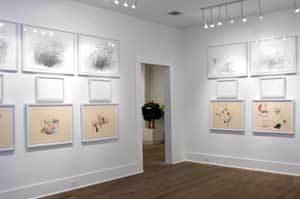
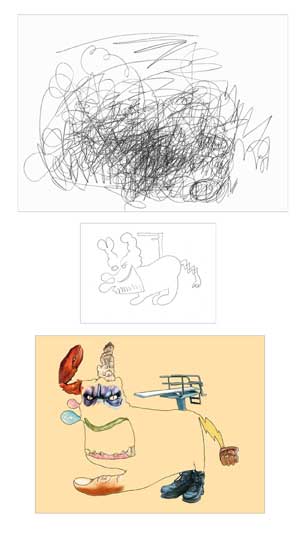
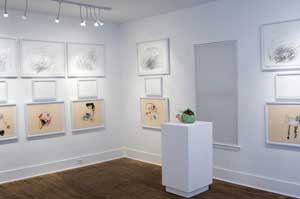
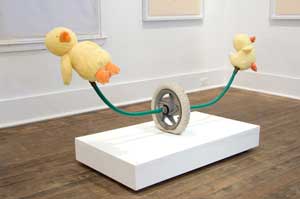
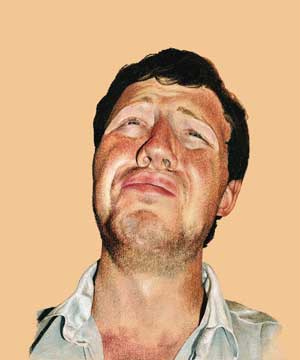


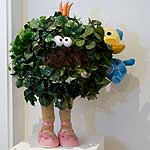

1 comment
“Art can’t come close to what a good pop song can do, conveying that kind of emotion.”
I would like a moustache helmet, pleese.